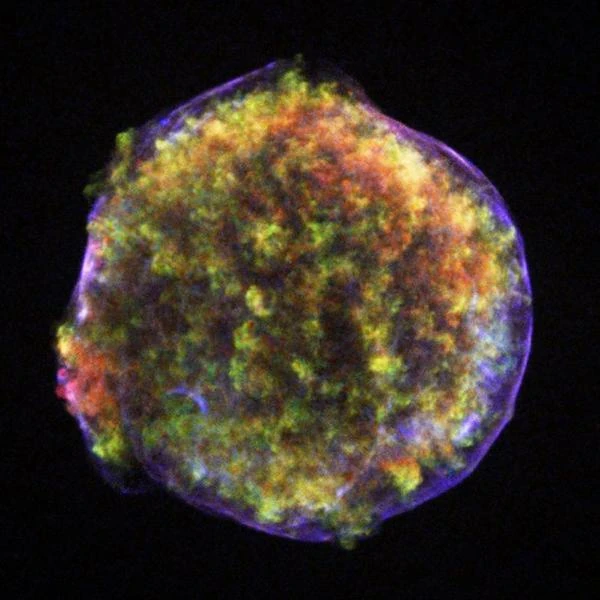
Image description: Tycho's supernova (SN 1572) was a nova that appeared in the constellation Cassiopeia in 1572. It was visible to the naked eye and observed by Tycho Brahe on November 11, 1572, when it was brighter than Venus. Tycho Brahe noticed that the position of the object did not move relative to the fixed stars, unlike planets. He concluded that it was not a planet, but a fixed star. By March 1574, it disappeared below the visibility threshold. Image credit public domain: composite image of SN 1572 viewed by Chandra X-ray. Chandra X-Ray Observatory, Spitzer Space Telescope, and Calar Alto Observatory.
The term "collapsar" combines the words "collapse" and "quasar." It was proposed in the 1990s to describe massive stars whose gravitational collapse generates a black hole, producing relativistic jets and gamma emissions. Collapsars are particularly associated with long-duration gamma-ray bursts (over two seconds), resulting from the collapse of massive stars and the rapid formation of black holes.
A collapsar is an astrophysical phenomenon resulting from the gravitational collapse of a massive star, generally with a mass greater than 20 times that of the Sun. This process leads to the formation of a black hole and can be the origin of gamma bursts, among the most energetic events observed in the universe.
At the end of its life, a massive star exhausts its nuclear fuel, leading to the production of an iron core. Unlike lighter elements, iron fusion does not emit energy. The core thus ceases to produce the pressure necessary to counteract gravitational attraction. When the mass of the core exceeds the Chandrasekhar limit (~1.4 solar masses), it collapses under its own weight. If the mass of the residual core exceeds about 3 solar masses, the star becomes a collapsar, forming a black hole.
When a collapsar forms, the collapsing stellar core continues to accumulate matter, forming an accretion disk around the forming black hole. The disk, heated by extreme gravitational forces and internal frictions, releases enormous amounts of energy. The matter in the disk is accelerated to relativistic speeds, and some is ejected as powerful jets, often aligned with the magnetic poles of the star.
The gamma-ray bursts (GRBs) associated with collapsars are bright explosions of gamma radiation. They are generated when the jets of relativistic matter penetrate the outer layers of the star and escape into space. The energy released by a gamma-ray burst is colossal, on the order of $10^{44}$ joules, in just a few seconds. These events allow us to study extreme phenomena such as general relativity, plasma physics, and the evolution of massive stars.
Collapses in a galaxy are numerous enough that the collapse scenario is known. Collapsars, through their link with the formation of black holes and gamma bursts, are key astrophysical phenomena for understanding the evolution of massive stars and the extreme mechanisms of the universe. Observing gamma bursts and collapsars allows us to explore energies and gravities so extreme that they push the limits of current physics.